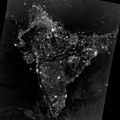File:India at night from space during Diwali 2012.jpg
Appearance

Size of this preview: 600 × 600 pixels. Other resolutions: 240 × 240 pixels | 480 × 480 pixels | 768 × 768 pixels | 1,024 × 1,024 pixels | 2,048 × 2,048 pixels | 4,218 × 4,218 pixels.
Original file (4,218 × 4,218 pixels, file size: 4.53 MB, MIME type: image/jpeg)
File history
Click on a date/time to view the file as it appeared at that time.
| Date/Time | Thumbnail | Dimensions | User | Comment | |
|---|---|---|---|---|---|
| current | 16:41, 9 November 2013 |  | 4,218 × 4,218 (4.53 MB) | Spideog | User created page with UploadWizard |
File usage
No pages on the English Wikipedia use this file (pages on other projects are not listed).
Global file usage
The following other wikis use this file:
- Usage on en.wikiquote.org
- Usage on ta.wikipedia.org


